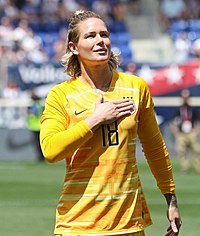
Photo from wikipedia
From a preventative perspective, leg axis and core stabilization capacities are important for soccer players and alpine skiers; however, due to different sport-specific demands, the role of laterality clearly differs… Click to show full abstract
From a preventative perspective, leg axis and core stabilization capacities are important for soccer players and alpine skiers; however, due to different sport-specific demands, the role of laterality clearly differs and may result in functional long-term adaptations. The aims of this study are 1) to determine whether there are differences in leg axis and core stability between youth soccer players and alpine skiers and 2) between dominant and non-dominant sides, and 3) to explore the outcomes of applying common sport-specific asymmetry thresholds to these two distinct cohorts. Twenty-one highly trained/national-level soccer players (16.1 years, 95% CI: 15.6, 16.5) and 61 alpine skiers (15.7 years, 95% CI: 15.6, 15.8) participated in this study. Using a marker-based 3D motion capture system, dynamic knee valgus was quantified as the medial knee displacement (MKD) during drop jump landings, and core stability was quantified as the vertical displacement during deadbug bridging exercise (DBB displacement ). For the analysis of sports and side differences, a repeated-measures multivariate analysis of variance was used. For the interpretation of laterality, coefficients of variation (CV) and common asymmetry thresholds were applied. There were no differences in MKD or DBB displacement between soccer players and skiers or between the dominant and non-dominant sides, but there was an interaction effect side*sports for both variables (MKD: p = 0.040, η2 p = 0.052; DBB displacement : p = 0.025, η2 p = 0.061). On average, MKD was larger on the non-dominant side and DBB displacement laterality on the dominant side in soccer players, whereas this pattern was reversed in alpine skiers. Despite similar absolute values and asymmetry magnitudes of dynamic knee valgus and deadbug bridging performance in youth soccer players and alpine skiers, the effect on the direction of laterality was opposite even though much less pronounced. This may imply that sport-specific demands and potential laterality advantages should be considered when dealing with asymmetries in athletes.
Journal Title: Frontiers in Physiology
Year Published: 2023
Link to full text (if available)
Share on Social Media: Sign Up to like & get
recommendations!